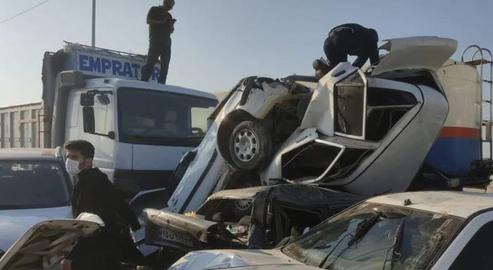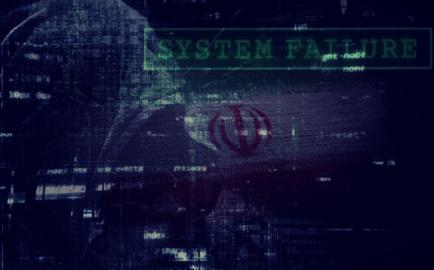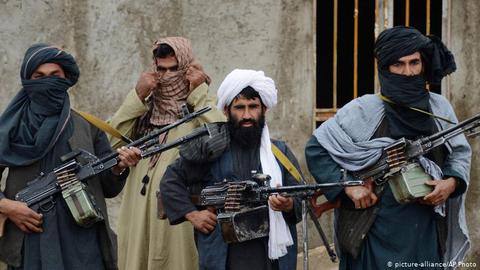Five people were killed and 41 more injured in a horrendous multi-car crash on the road from Behbahan to Ramhormoz, Khuzestan, on Monday. Two days later General Kamal Hadianfar, commander of Iran’s Traffic Police, revealed that not one of the airbags in the affected cars had inflated as they should have. He sharply criticized the country’s domestic car manufacturers, calling Iran-made cars “chariots of death”.
Following this announcement, the Iran Central Bar Association asked Iran’s prosecutor-general to press charges against a string of automakers via a “public lawsuit”, as well as inspectors tasked with reviewing vehicle standards.
A person who lost three loved ones on the road in Khuzestan commented: “Mr. Traffic Police says these are chariots of death. I only wish there were somebody who could ask him, the one who’s responsible for licensing these cars, on behalf of us, the grieving ones: ‘If you knew this, why did you give them license plates?’
“My loved one burned to ashes in those cars. I hope a public lawsuit will get results. I mean, for the future, because my loved ones are not going to come back.”
The models of the cars involved in the incident were not specified in Iranian media. But pictures showed most of those visible Iranian-made cars including the Kia Pride and Samand.
Peyman Pirayesh, director-general of the Institute of Standard and Industrial Research of Iran (ISIRI), said before anything else, it should be determined whether the passenger-side airbags had been locked or not. If police found that the car manufacturers were at fault, he said, the issue would go to the courts.
Figures announced by Iran’s Traffic Police indicate that every hour, two people on average lose their lives in traffic collisions, and 20 to 25 are injured.
How is it that Iranian car manufacturers have gotten away with this until now? We looked into what’s known about this sprawling, unaccountable industry – and how much of a chance any “public lawsuit” might have.
***
“I lost the dearests in my life, my beautiful wife and my precious child, in 2011 on the same road in one of the same chariots of death,” says Soleiman Ahmadi, a lump in his throat and tears in his eyes. “Since then, how many times do you think I’ve tried to sue? How many times could you believe I’ve been passed and re-passed from court to court? The result: nothing!”
Ahmadi is a resident of Khuzestan, who that year lost his 22-year-old wife Maryam and six-month-old baby in a car crash on the same stretch of road as Monday’s disastrous incident. The braking system in their Kia Pride stopped working. He was the only one to survive, with severe leg injuries.
“It happened in the March,” Ahmadi says. “For six months we’d had to stay home to care for our child. On March 5, we set out from Ahvaz to Ramhormoz, where my father-in-law lived. We’d planned to go from there to my parents’ home a few day before New Year [the Iranian new year, on March 20].
“We’d only bought the car recently. It was a Pride that Maryam happened to like very much. From the very get-go, I had to speak on several occasions with the company about a technical issue with the brake. Sometimes it worked, sometimes it didn’t, and screeched.
“The day before our trip I once again took the car to their servicing center. They checked it and said there were no problems. They also changed the brake fluid. We set off towards Behbahan at around 3pm. It’s a dangerous one; for years people have called it the ‘Death Road’. The asphalt is non-standard and in many places there’s no hard shoulder. Every year there are a few fatal crashes. In our case, the problem with the car was added to the problem of the road.”
Despite the checkup and the new brake fluid, the brakes then failed. Ahmadi lost control of the car, which careered straight into the path of an approaching Nissan. In the headlong collision, Ahmadi recalls, “My wife had her seatbelt on, but the baby, whom she’d been holding, went through the windshield.
“They’ve operated on my legs a number of times over the past 10 years. Perhaps they’ll mend. But the wound on my soul will never heal. My lawsuit got nowhere, and in the end they found the driver of the Nissan at fault. But even if he was guilty, my brakes played a part in the chain of events.”
International Standards and Iranian-Made Cars
Haifa Asadi is an engineer and project manager at an automaker affiliated with Volvo in Europe. IranWire asked her for her understanding of whether Iranian automakers complied with the international industry standards.
“First, let’s talk a little about manufacturers’ responsibilities,” she said. “In 2020, after defects were discovered in the airbags of some of its car models, General Motors recalled seven million of the cars it had sold at no cost to the client. It suffered a loss of close to two million dollars.
“In 2007, after a fatal accident involving a Toyota Camry, that company recalled about 2.5 million cars that might have had the same software defect, and stopped making the model for a while. It paid millions of dollars in fines. In news footage, we saw the CEO of Toyota bowing in front of the cameras.
“That accident led to the new international standard, called ISO 26262: a functional safety standard for developers of automotive hardware and software. All countries have to comply with it, meaning that not one car, not one Pride, not one Peugeot, can roll out of the factory and be sold to a customer without passing the safety tests. Some tests even have to be performed two to three times on each car.
“But investigations show that many international standards are completely ignored in Iran, and Iranian automakers don’t comply with them in their manufacturing process.”
After the pile-up on Monday, Mehdi Eslam-Panah, president of Iran’s Standards Organization for the automotive industry, told a special news program: “automakers have pledged to us that they will comply with many of the mandatory standards that they have been resisting implementing. If they refuse to do so, we will prevent the cars they manufacture from getting license plates.”
Eslam-Panah went on to claim that under the Rouhani administration, nine of the 85 standards that should apply to car manufacturing had been “suspended” – and that was why they had been flouted in Iran on various pretexts since.
Iran Car Manufacturers’ Shady Ties to Government
Haifa Asadi believes that when it comes to road safety, corrupt connections are often prioritized over the value of human life. “How can such a technical disgrace happen in Iran not once but several times, and yet nothing is done to set it right?
“The motto of the manufacturing company I work for is ‘Customers’ Success’. These companies are duty-bound to protect their customers’ safety. If they neglect to do so, then governments are responsible for attending to their failure. In Iran, however, these firms are protected by the state as partners to the government’s corruption. Naturally, they have no answers.”
The two major Iranian automakers with the biggest share of the market are Saipa and Iran Khodro. The Islamic Republic is adamant that these two are private-sector firms. But contrary to statements by the Ministry of Industry, Mine and Trade, both are practically parastatal entities; they are majority-owned by actors like the Industrial Development and Renovation Organization of Iran (IDRO) and other state entities.
In March 2018, General Taghi Mehri, the then-commander of the Traffic Police, reported that 52 percent of fatalities in Iranian road traffic collisions were passengers of Pride and Peugeot cars, and more than 70 percent of Iranian-made cars did not have functioning airbags.
In September last year General Teymour Hosseini, deputy commander of the Traffic Police, also criticized the quality and the safety of Iranian-made cars. He quipped: “If an automobile can comply with the toothless Euro 5 [emissions] standard, then we say the job is finished.” Pointing out that other big global carmakers were now working on electric vehicles and self-driving cars, he lamented: “Our expectations so low we’re satisfied with an anti-lock brake system.”
What Can a ‘Public Lawsuit’ Achieve?
In its statement of January 12, the Iran Central Bar Association said the public wants to see preventive measures and legal action taken so that the so-called “chariots of death” would be taken off the roads.
Musa Barzin Khalifehloo, lawyer and IranWire’s advisor in legal affairs, said of the definition of a “public lawsuit”: “A series of offences and crimes in Iran are deemed ‘private’, like assault and battery. They need a complaint by the victim to be investigated.
“On the other hand, a series of other offences have a public aspect, like destroying historical monuments or crimes against national security. In these cases, there is no need for a private plaintiff: the prosecutor can act as a party to the lawsuit.
“The Bar Association is saying that the issue of airbags that didn’t inflate in any of the cars in the accident is no longer a private matter. A number of passengers lost their lives, and a number were injured, as a result of negligence by the automakers.”
In such cases, Khalifehloo says, the prosecutor would be within their rights to initiate a public lawsuit. “But whether the case will get anywhere or not is another matter. First, automakers and part makers, the Standards Organization and the Ministry of Industry, would all have to be held accountable. We’ll see how they answer to this lawsuit as a public case.
“Either way, after the litigation is over or even during it, the consumers and those who have been hurt in the accident can also sue the automakers. Unfortunately, a public lawsuit by the prosecutor doesn’t mean by itself that anyone will be convicted.”
Related Coverage:
Why the Revolutionary Guards Will Fail Iran’s Car Industry
The Futile Investigation Into Iran's Labyrinthine Auto Manufacturing Industry
The Dark Side: How a Corrupt 'Privatization' Drive Led to Blackouts in Iran
Government Report Reveals More Corrupt Privatization Practices in Iran
Official Report: Iran’s Military is Riddled with Corruption
Are the Revolutionary Guards’ Economic Activities Legal?
Reality Check: Ebrahim Raisi's Record in Fighting Corruption
Fact Check: Does the Islamic Republic Really Fight Corruption?
visit the accountability section
In this section of Iran Wire, you can contact the officials and launch your campaign for various problems






















comments